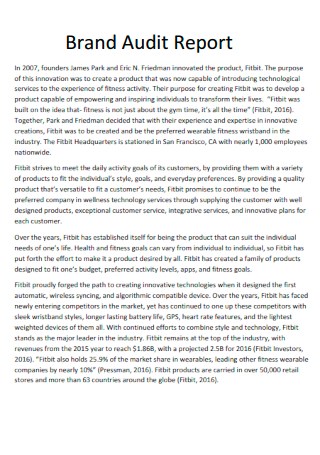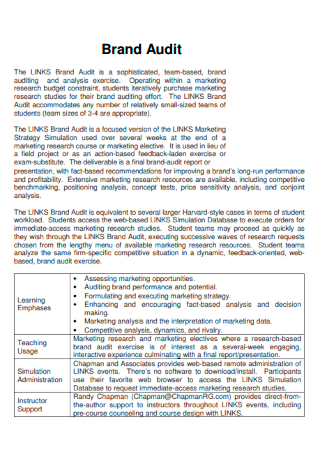Sir Richard Branson said: “Branding demands commitment: commitment to continual reinvention, striking chords with people to stir their emotions, and commitment to imagination. It is easy to be cynical…
continue reading
20+ SAMPLE Brand Audit
-

Impact Brand Audit Worksheet
download now -

Brand Audit and Style
download now -

Brand Audit Report
download now -

Sample Brand Audit
download now -

Brand Audit and Perception Survey
download now -

Brand Audit Executive Summary
download now -

Brand Audit and Improvement
download now -

Audit Brand Elements
download now -

Brand Audit Survey
download now -

Personal Brand Audit
download now -

Employer Brand Audit Checklist
download now -

Basic Brand Audit
download now -

Brand Audit Method
download now -

Brand Audit Checklist
download now -

Brand Audit Questionnaire
download now -

Brand Audit Outline
download now -

Formal Brand Audit
download now -

High-Level Brand Audit
download now -

Printable Brand Audit
download now -

Brand Audit Core Identity
download now -

Online Brand Audit
download now
What Is a Brand Audit?
A brand audit thoroughly examines your brand’s position in the marketplace, its strengths and weaknesses, and recommendations for improvement. During a brand audit, three areas should be discussed: Internal branding encompasses your company’s brand values, mission, and culture. According to research, your company’s most valuable asset is its brand. On average, brands account for 19.5% — and in some cases, more than 50 percent — of enterprise value.
Benefits of Brand Audits
It can sometimes feel that the most prominent brands put in all the effort early on and are still reaping the benefits years later. Indeed, it is frequently the case that established businesses struggle to remain innovative and agile as they grow. It takes a great deal of action to maintain a position at the top, with every upstart attempting to usurp your brand. Continuous monitoring of results and reporting on progress toward goals serves as a health check. Conducting a brand audit enables you to step back and assess the big picture, which can help inform a longer-term strategy. If you’re curious about brand auditing’s benefits, here are some of them:
How To Conduct a Brand Audit
While big organizations may hire a brand specialist to perform brand audits, this is not always necessary. Additionally, a marketing officer can perform this function. In small businesses, a team can conduct a brand audit collaboratively and learn a great deal about their brand. The examples above demonstrate that not all brand audits are the same. However, they share one thing in common: how they are conducted. The steps below outline how to conduct a brand audit of your own business.
1. Establish a Brand Auditing Framework
It’s beneficial to have a brand analysis template or framework to guide you through the auditing process. A brand audit template is available for download here. If you’re wondering how to conduct a brand audit, the first step is to create a framework for the process. Mainly if you’re performing this internally, you’ll need a road map to ensure that the data you collect is actionable—easy it’s to get lost in the numbers, so zero in on the information that matters to your brand. Create a framework for your investigation by creating a list of the items examined and the methods you will use. It’s beneficial to organize your list to include internal and external brand elements.
2. Analyze the Analytics for Your Website
You could have the most beautiful landing page design globally, but it’s critical to understand where and why it’s failing if it’s not converting or serving your customers adequately. It is essential to conduct a digital brand audit using a web analytics platform. Utilizing a platform like Google Analytics will provide you with rich historical and real-time analytics data that you can use to conduct assessments and gain a better understanding of your target audience.
3. Analyze Your Sales Records
You should be accomplishing this regularly, but it can provide information about your brand audit’s customer and industry trends. Here, you’ll assess whether you’ve adhered to your brand promise to deliver what customers want and whether you’re keeping up with competitors and their offerings. An in-depth examination of your sales data reveals customer purchasing patterns and enables you to refocus your efforts. Have you noticed any unusual declines in sales? How about relocating the purchasers? These points should be analyzed to determine your brand’s health and its impact on sales.
4. Examine And Review Your Social Media Data
Social media supplies you with a wealth of information about your customers that you cannot obtain in any other way. What’s genuinely enlightening is the realization that your target customers may not be the ones who engage with your social media channels. Indeed, this is much more common than you might believe. This valuable demographic information enables you to understand your audience better and rethink your social communication strategy. It’s easy to get hooked up in vanity social metrics like follower count or even likes, but if you’re not appealing to your ideal buyer on social, there’s something wrong with your branding and social strategy.
5. Keep an Eye on Your Competitors
To get a complete view of the competitive landscape, you’ll need to determine how well your competitors’ brands perform. What type of content are they producing? Is their brand gaining traction? Are they in the process of forming any brand partnerships? While some of this work will be manual, there are tools available to delve deeper into specific brand elements. Competitor analysis tools provide SEO-driven data and assist you in monitoring your niche and conducting competitor research. Obtain information about their organic traffic, keywords, and how you rank in comparison. After all, people frequently discover brands while conducting a Google search for topics of interest. There is an issue if your competitors rank for these keywords but you do not.
6. Obtain Responses From Your Customers
To speak effectively with your clients, you must first learn what they think and say about your brand. Investigate your customers’ minds to know what motivates them, what makes them tick, and influences their purchasing conclusions. Polls and surveys are practical tools and tactics for obtaining valuable customer data for brand analysis.
How To Create a Brand Audit
The first step in achieving a brand audit is maintaining an open mind. Do not stop there when you come across roadblocks and consider possible solutions. Continue the brand audit process to the end to truly see the results. Consider a brand audit in the same way you would a course of antibiotics. While starting halfway may help, the effects will not last until you complete it. This section will summarize the steps necessary to conduct a brand audit.
1. Consider the objective of your brand audit.
When conducting a brand audit, the first step is to brainstorm what should be analyzed. Perhaps your website or social media efforts are to blame. Maybe it is everything! Utilize the mind map template to jot down brand-related ideas and questions. Consider your mind map as a questionnaire for conducting a brand audit. This will serve as the foundation for your brand audit framework and will assist you in locating the necessary information.
2. Define the audit’s ultimate objective.
After you’ve brainstormed the issues you’d like to address or improve your brand, it’s time to establish some brand goals. Goals can be broad and far-reaching or specific, depending on the objective. Whichever it is, determine what you want to accomplish with the brand audit and begin organizing. This is the section of your brand audit where you will note what is not working about your brand. After completing all necessary tasks, you return to this stage and revisit the vision you had at the start. Occasionally, the process will be straightforward, and you will immediately recognize what needs to be done. In other cases, you’ll need to test several alternative solutions until the best one emerges.
3. Create a plan based on your objectives.
This is the stage at which you develop a strategy for your brand. Create a checklist that you can use with your team or on your own if necessary. Additionally, adding levels to your inventory may be beneficial — one main list with sub-tasks. Assign tasks to team members and, if necessary, explain how to complete them. Another aspect of the strategy and planning stage is establishing deadlines for various tasks. To assist your team in remaining organized and focused, you can create a table or a Gantt chart. Additionally, you may want to conduct a SWOT analysis of your brand. A SWOT analysis is a process that identifies your brand’s strengths, weaknesses, opportunities, and threats on a broad or specific level.
4. Organize and review data.
Now is the moment to begin gathering data for your brand assessment. Create your questions and allot sufficient room to jot down notes and data. Additionally, you should perform a poll of your consumers and those who may have heard of your brand but are not yet clients. Ensure that you complete all steps and record as much information about your findings. If it’s more convenient, keep the results on a whiteboard using sticky notes. Respond to all questions and structure your responses to make them easier to examine later. Quantitative data should be entered into spreadsheets, whereas qualitative data should be entered into documents. When working in a team, compare results as you complete assignments. However, refrain from making any changes until you’ve addressed all relevant questions from your brand audit. This stage may take some time, depending on the amount of data you need to collect and the number of people involved.
5. Analyze the results and generate possible solutions.
After collecting and organizing the data, it’s time to examine the outcomes of the brand audit to recommend acceptable remedies. One strategy for analyzing your findings is to display the data and offer it in an easily-digestible style, such as the one shown below. If you’re conducting the brand audit independently, you may require assistance at this point. Ideation is challenging to perform alone – you need a brainstorming partner. This is where you’ll identify the strengths and flaws of your brand. Make two separate lists of the strongest and weakest points. Now consider how your brand’s strengths can assist mitigate its faults. An alternative option would be to incorporate graphics into your emails and keep the text minimum. Utilize the visuals that work on other platforms to fill in the gaps in your emails. Invite team members to provide their thoughts as well.
6. Take action and maintain surveillance.
Consider which of your ideas are the simplest and most practical to implement. For instance, you may have noticed that the URLs for your social media profiles differ from those for your domain. That could be why people are having difficulty locating you. A simple option is to update your social media profiles to reflect your brand or domain name. Perhaps you’ve realized that your blog posts’ stock photos are buried in a sea of similarity. Customize the images by modifying them, making your designs, or hiring a photographer.
FAQs
What is the function of a brand audit?
A brand audit is a thorough check of your business that identifies your brand’s position in the market. A brand audit helps you identify your business’s strengths, opportunities, and areas for improvement compared to your competitors, using statistical data and genuine customer and stakeholder information.
How is internal brand audit done?
A brand audit thoroughly analyzes your brand’s performance about its stated objectives. Taking a step back and viewing your brand through a different lens enables you to see the bigger picture and uncover your company’s strengths and weaknesses.
What is the purpose of a brand tracking study?
Brand tracking studies are designed to assess the success of brand-building projects by examining their influence on both the consumer and the business. Brand monitoring studies concerned with business impact rely heavily on financial measures to calculate the return on investment of brand creation projects.
It’s now your time! Are you prepared to do a brand audit on your business, organization, or startup? Utilize the brand audit template provided above to get started quickly. You’ll be able to customize the template and make it uniquely yours. You can easily adjust the colors, fonts, text, and images using the drag-and-drop editor. Begin your brand audit today and identify the hurdles impeding your growth.


